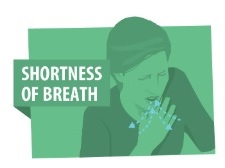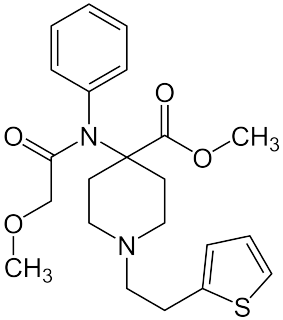Related Research Articles

Fentanyl, also spelled fentanil, is an opioid used as a pain medication and together with other medications for anesthesia. It is also used as a recreational drug, often mixed with heroin or cocaine. It has a rapid onset and its effects generally last under two hours. Medically, it is used by injection, nasal spray, skin patch, or absorbed through the cheek (transmucosal) as a lozenge or tablet.

Shortness of breath (SOB), also known as dyspnea is a feeling of not being able to breathe well enough. The American Thoracic Society defines it as "a subjective experience of breathing discomfort that consists of qualitatively distinct sensations that vary in intensity", and recommends evaluating dyspnea by assessing the intensity of the distinct sensations, the degree of distress involved, and its burden or impact on activities of daily living. Distinct sensations include effort/work, chest tightness, and air hunger.

General anaesthesia or general anesthesia is a medically induced coma with loss of protective reflexes, resulting from the administration of one or more general anaesthetic agents. It is carried out to allow medical procedures that would otherwise be intolerably painful for the patient; or where the nature of the procedure itself precludes the patient being awake.

Pethidine, also known as meperidine and sold under the brand name Demerol among others, is a synthetic opioid pain medication of the phenylpiperidine class. Synthesized in 1938 as a potential anticholinergic agent by the German chemist Otto Eisleb, its analgesic properties were first recognized by Otto Schaumann while working for IG Farben, Germany. Pethidine is the prototype of a large family of analgesics including the pethidine 4-phenylpiperidines, the prodines, bemidones and others more distant, including diphenoxylate and analogues.

Midazolam, marketed under the trade name Versed, among others, is a benzodiazepine medication used for anesthesia, procedural sedation, trouble sleeping, and severe agitation. It works by inducing sleepiness, decreasing anxiety, and causing a loss of ability to create new memories. It is also useful for the treatment of seizures. Midazolam can be given by mouth, intravenously, or injection into a muscle, by spraying into the nose, or through the cheek. When given intravenously, it typically begins working within five minutes; when injected into a muscle, it can take fifteen minutes to begin working. Effects last for between one and six hours.

An anesthetic or anaesthetic is a drug used to induce anesthesia — in other words, to result in a temporary loss of sensation or awareness. They may be divided into two broad classes: general anesthetics, which result in a reversible loss of consciousness, and local anesthetics, which cause a reversible loss of sensation for a limited region of the body without necessarily affecting consciousness.

Pulmonary hypertension is a condition of increased blood pressure within the arteries of the lungs. Symptoms include shortness of breath, syncope, tiredness, chest pain, swelling of the legs, and a fast heartbeat. The condition may make it difficult to exercise. Onset is typically gradual.

Irukandji syndrome is a condition that results from envenomation by certain box jellyfish. In rare instances the sting may result in cardiac arrest and death. The most common jellyfish involved is the Carukia barnesi, a species of Irukandji jellyfish. Those stung may experience severe or even excruciating pain.

Sufentanil, sold under the brand names Dsuvia and Sufenta, is a synthetic opioid analgesic drug approximately 5 to 10 times as potent as its parent drug, fentanyl, and 500 times as potent as morphine. Structurally, sufentanil differs from fentanyl through the addition of a methoxymethyl group on the piperidine ring, and the replacement of the phenyl ring by thiophene. Sufentanil first was synthesized at Janssen Pharmaceutica in 1974.

Alfentanil is a potent but short-acting synthetic opioid analgesic drug, used for anaesthesia in surgery. It is an analogue of fentanyl with around 1/4 to 1/10 the potency of fentanyl and around 1/3 of the duration of action, but with an onset of effects 4x faster than fentanyl. Alfentanil has a pKa of approximately 6.5, which leads to a very high proportion of the drug being uncharged at physiologic pH. This unique characteristic is responsible for its rapid onset. It is an agonist at mu opioid receptors.

Remifentanil is a potent, short-acting synthetic opioid analgesic drug. It is given to patients during surgery to relieve pain and as an adjunct to an anaesthetic. Remifentanil is used for sedation as well as combined with other medications for use in general anesthesia. The use of remifentanil has made possible the use of high-dose opioid and low-dose hypnotic anesthesia, due to synergism between remifentanil and various hypnotic drugs and volatile anesthetics.
In advanced airway management, rapid sequence induction (RSI) – also referred to as rapid sequence intubation or as rapid sequence induction and intubation (RSII) – is a special process for endotracheal intubation that is used where the patient is at a high risk of pulmonary aspiration. It differs from other techniques for inducing general anesthesia in that several extra precautions are taken to minimize the time between giving the induction drugs and securing the tube, during which period the patient's airway is essentially unprotected.

Irukandji jellyfish are any of several similar, extremely venomous species of box jellyfish. With an adult size of about a cubic centimeter (1 cm3), they are both the smallest and one of the most venomous jellyfish in the world. They inhabit the northern marine waters of Australia. They are able to fire their stingers into their victim, causing symptoms collectively known as Irukandji syndrome. There are about 16 known species of Irukandji, of which Carukia barnesi, Malo kingi, Malo maxima, Malo filipina and Malo bella are the best-known.

Dexmedetomidine, sold under the trade name Precedex among others, is an anxiety reducing, sedative, and pain medication. Dexmedetomidine is notable for its ability to provide sedation without risk of respiratory depression and can provide cooperative or semi-rousable sedation.

Piritramide is a synthetic opioid analgesic that is marketed in certain European countries including: Austria, Belgium, Czech Republic, Germany and the Netherlands. It comes in free form, is about 0.75x times as potent as morphine and is given parenterally for the treatment of severe pain. Nausea, vomiting, respiratory depression and constipation are believed to be less frequent with piritramide than with morphine, and it produces more rapid-onset analgesia when compared to morphine and pethidine. After intravenous administration the onset of analgesia is as little as 1–2 minutes, which may be related to its great lipophilicity. The analgesic and sedative effects of piritramide are believed to be potentiated with phenothiazines and its emetic (nausea/vomiting-inducing) effects are suppressed. The volume of distribution is 0.7-1 L/kg after a single dose, 4.7-6 L/kg after steady-state concentrations are achieved and up to 11.1 L/kg after prolonged dosing.

Mephentermine is a cardiac stimulant. It was formerly used in Wyamine nasal decongestant inhalers and before that as a stimulant in psychiatry.
Persistent fetal circulation is a condition caused by a failure in the systemic circulation and pulmonary circulation to convert from the antenatal circulation pattern to the "normal" pattern. Infants experience a high mean arterial pulmonary artery pressure and a high afterload at the right ventricle. This means that the heart is working against higher pressures, which makes it more difficult for the heart to pump blood.

Acetylfentanyl is an opioid analgesic drug that is an analog of fentanyl. Studies have estimated acetylfentanyl to be fifteen times more potent than morphine. It has never been licensed for medical use and instead has only been sold as a designer drug. Acetylfentanyl was discovered at the same time as fentanyl itself and had only rarely been encountered on the illicit market in the late 1980s. However, in 2013, Canadian police seized 3 kilograms of acetylfentanyl. As a μ-opioid receptor agonist, acetylfentanyl may serve as a direct substitute for heroin or other opioids. Common side effects of fentanyl analogs are similar to those of fentanyl itself, which include itching, nausea and potentially serious respiratory depression, which can be life-threatening. Fentanyl analogs have killed hundreds of people throughout Europe and the former Soviet republics since the most recent resurgence in use began in Estonia in the early 2000s, and novel derivatives continue to appear.

Coinduction in anesthesia is a pharmacological tool whereby a combination of sedative drugs may be used to greater effect than a single agent, achieving a smoother onset of general anesthesia. The use of coinduction allows lower doses of the same anesthetic agents to be used which provides enhanced safety, faster recovery, fewer side-effects, and more predictable pharmacodynamics. Coinduction is used in human medicine and veterinary medicine as standard practice to provide optimum anesthetic induction. The onset or induction phase of anesthesia is a critical period involving the loss of consciousness and reactivity in the patient, and is arguably the most dangerous period of a general anesthetic. A great variety of coinduction combinations are in use and selection is dependent on the patient's age and health, the specific situation, and the indication for anesthesia. As with all forms of anesthesia the resources available in the environment are a key factor.

Thiafentanil is a highly potent opioid analgesic that is an analog of fentanyl, and was invented in 1986. It is similar to carfentanil though with a faster onset of effects, shorter duration of action and a slightly lesser tendency to produce respiratory depression. It is used in veterinary medicine to anesthetise large animals such as impala, usually in combination with other anesthetics such as ketamine, xylazine or medetomidine to reduce the prevalence of side effects such as muscle rigidity.
References
- ↑ Chambers, David; Huang, Christopher; Matthews, Gareth (2014). "Anaesthesia and the Lung". Basic Physiology for Anaesthetists (illustrated ed.). Cambridge: Cambridge University Press. p. 107. ISBN 9781107637825 . Retrieved 2015-01-31.
- 1 2 Gussow, Leon (March 25, 2016). "Is possible chest wall rigidity after illicit intravenous fentanyl administration clinically significant?". The Poison Review. Retrieved 2018-04-01.
- ↑ Tanus-Santos, Jose Eduardo (30 November 1998). "Fentanyl is not best anaesthetic induction agent in rapid sequence intubation". The BMJ. Retrieved 2018-04-01.
| This article about a disease, disorder, or medical condition is a stub. You can help Wikipedia by expanding it. |